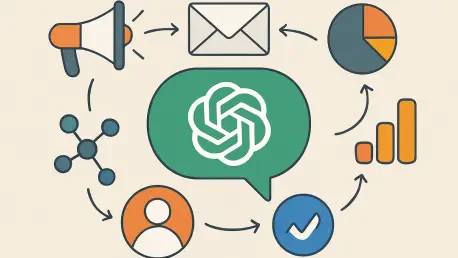Imagine a digital landscape where a single platform not only answers queries but also seamlessly connects users to a myriad of services, from booking travel to designing graphics, all within a conversational flow. This is the transformative reality that OpenAI has ushered in with its latest update to ChatGPT, evolving it from a mere chatbot into a robust platform for third-party app integrations. With a staggering user base of 800 million, ChatGPT is no longer just a tool for casual conversation; it’s becoming a high-intent marketing channel that could rival traditional search engines. This shift opens up unprecedented opportunities for brands to engage with consumers at the exact moment of need, blending utility with commerce in a way that feels natural and intuitive. As the digital world moves toward more integrated experiences, ChatGPT’s latest advancements signal a profound change in how marketing strategies might unfold, promising a future where context and intent drive every interaction.
The Evolution of ChatGPT as a Platform
A Conversational Operating System
ChatGPT’s transformation into what can be described as a conversational operating system marks a significant departure from its origins as a standalone chatbot. This update allows users to interact with a variety of third-party apps like Spotify, Canva, and Expedia directly within the chat interface, creating a seamless experience where switching between services feels effortless. For instance, while discussing travel plans, a user can summon Booking.com to make reservations without ever leaving the conversation. This integration is designed to keep users immersed in the platform for extended periods, as envisioned by product leaders at OpenAI. The goal is to craft an environment where software and services converge in a unified interface, eliminating the fragmented nature of traditional app-hopping. For marketers, this presents a unique chance to position their brands within these conversational flows, meeting consumers at critical decision-making junctures with tailored solutions that feel less like advertisements and more like helpful recommendations.
Tools for Developers and Future Growth
Beyond user experience, OpenAI has introduced an Apps SDK that empowers developers to create interactive elements such as dynamic visuals and engaging interfaces within ChatGPT. This toolkit is a game-changer, enabling the development of apps that can stand out in a crowded digital space. Plans for an app store and a review system, slated for rollout in the near future, aim to further enhance visibility for high-quality applications, ensuring that users can easily discover tools that meet their needs. This infrastructure not only supports innovation but also lays the groundwork for a marketplace where brands can gain prominence through well-designed, user-friendly integrations. The implications for marketing are vast, as companies can leverage these tools to craft experiences that resonate deeply with users, turning casual interactions into meaningful engagements. As more developers join this ecosystem, the potential for diverse and creative marketing solutions will likely expand, setting the stage for a new era of digital interaction.
Marketing Opportunities in a New Digital Frontier
Contextual Engagement and High-Intent Discovery
One of the most compelling aspects of ChatGPT’s evolution is its potential to serve as a discovery and conversion engine for brands. With an enormous user base actively seeking solutions through conversation, companies have the opportunity to appear precisely when intent is highest, bypassing the scattershot approach of traditional search or social media advertising. Imagine a user discussing fitness goals and instantly being connected to Peloton for a workout plan or Instacart for healthy meal ingredients—all within the same chat window. This contextual engagement shifts the paradigm from interruptive marketing to a more organic form of connection, where brands become part of the solution rather than a distraction. As integrations with major players like Target and Uber roll out, the platform’s ability to facilitate direct, intent-driven interactions will only grow, offering marketers a powerful tool to build trust and drive conversions in a space where users are already primed to act.
The Rise of Agentic Commerce and Ad Tech
Another transformative element lies in the concept of agentic commerce, where transactions can occur with minimal friction directly within ChatGPT. Features like one-click purchases or in-chat shopping experiences with platforms like Etsy for U.S. users hint at a future where commerce and conversation are indistinguishable. OpenAI is also exploring the development of ad tech and attribution tools, which could provide marketers with detailed insights into user behavior and campaign effectiveness within this ecosystem. This move toward blending utility, engagement, and commerce in a single interface reflects a broader industry trend of prioritizing integrated digital experiences over fragmented ones. For brands, this means the ability to not only reach consumers at the right moment but also to close the loop on transactions without ever losing the user’s attention. As these capabilities mature, they could redefine how marketing budgets are allocated, focusing more on platforms that deliver immediate, measurable impact.
Looking Back at a Game-Changing Shift
Reflecting on the strides made with ChatGPT’s integration of third-party apps, it’s clear that a significant pivot in digital marketing has taken root. The platform has successfully blurred the lines between conversation, utility, and commerce, offering brands a novel way to connect with consumers through context-driven interactions. Marketers who adapted early to this shift found themselves at an advantage, leveraging the immense user base to deliver targeted, meaningful engagements. Moving forward, the challenge lies in continuously innovating within this conversational ecosystem, ensuring that app integrations remain intuitive and valuable to users. Brands are encouraged to explore partnerships and develop creative solutions using the Apps SDK, while keeping an eye on emerging ad tech tools to refine their strategies. As the digital landscape continues to evolve, staying agile and consumer-focused within platforms like ChatGPT will be key to sustaining relevance and driving growth in an increasingly integrated world.









